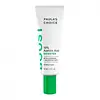What's inside
What's inside
 Key Ingredients
Key Ingredients

 Benefits
Benefits

 Concerns
Concerns

 Ingredients Side-by-side
Ingredients Side-by-side

Water
Skin ConditioningSqualane
EmollientPropanediol
SolventGlycerin
HumectantDiphenylsiloxy Phenyl Trimethicone
Skin ConditioningMel
EmollientJojoba Esters
EmollientC15-19 Alkane
SolventTheobroma Grandiflorum Seed Butter
Skin ConditioningArachidyl Alcohol
EmollientCetyl Alcohol
EmollientStearyl Alcohol
EmollientPolyglycerin-3
HumectantRoyal Jelly
Behenyl Alcohol
EmollientC10-18 Triglycerides
EmollientDimethicone/Phenyl Vinyl Dimethicone Crosspolymer
Phenoxyethanol
PreservativeParfum
MaskingDecyloxazolidinone
AntimicrobialDimethicone
EmollientSodium Stearoyl Glutamate
CleansingAvena Sativa Kernel Extract
AbrasiveArachidyl Glucoside
EmulsifyingHydroxyethyl Acrylate/Sodium Acryloyldimethyl Taurate Copolymer
Emulsion StabilisingAcrylates/C10-30 Alkyl Acrylate Crosspolymer
Emulsion StabilisingCaprylyl Glycol
EmollientTocopheryl Acetate
AntioxidantPolyglyceryl-3 Beeswax
EmulsifyingSodium Citrate
BufferingCitric Acid
BufferingXanthan Gum
EmulsifyingDisodium EDTA
Glyceryl Polymethacrylate
Sodium Hydroxide
BufferingCentella Asiatica Leaf Extract
Skin ConditioningSodium Hyaluronate
HumectantPolysorbate 60
EmulsifyingSorbitan Isostearate
EmulsifyingSodium Benzoate
MaskingPEG-8
HumectantSodium Tocopheryl Phosphate
AntioxidantHyaluronic Acid
HumectantCaramel
Cosmetic ColorantTocopherol
AntioxidantSodium Lactate
BufferingCI 19140
Cosmetic ColorantCI 15985
Cosmetic ColorantBHT
AntioxidantPalmitoyl Hexapeptide-12
Skin ConditioningWater, Squalane, Propanediol, Glycerin, Diphenylsiloxy Phenyl Trimethicone, Mel, Jojoba Esters, C15-19 Alkane, Theobroma Grandiflorum Seed Butter, Arachidyl Alcohol, Cetyl Alcohol, Stearyl Alcohol, Polyglycerin-3, Royal Jelly, Behenyl Alcohol, C10-18 Triglycerides, Dimethicone/Phenyl Vinyl Dimethicone Crosspolymer, Phenoxyethanol, Parfum, Decyloxazolidinone, Dimethicone, Sodium Stearoyl Glutamate, Avena Sativa Kernel Extract, Arachidyl Glucoside, Hydroxyethyl Acrylate/Sodium Acryloyldimethyl Taurate Copolymer, Acrylates/C10-30 Alkyl Acrylate Crosspolymer, Caprylyl Glycol, Tocopheryl Acetate, Polyglyceryl-3 Beeswax, Sodium Citrate, Citric Acid, Xanthan Gum, Disodium EDTA, Glyceryl Polymethacrylate, Sodium Hydroxide, Centella Asiatica Leaf Extract, Sodium Hyaluronate, Polysorbate 60, Sorbitan Isostearate, Sodium Benzoate, PEG-8, Sodium Tocopheryl Phosphate, Hyaluronic Acid, Caramel, Tocopherol, Sodium Lactate, CI 19140, CI 15985, BHT, Palmitoyl Hexapeptide-12
Water
Skin ConditioningAzelaic Acid
BufferingC12-15 Alkyl Benzoate
AntimicrobialCaprylic/Capric Triglyceride
MaskingMethyl Glucose Sesquistearate
EmollientGlycerin
HumectantCetearyl Alcohol
EmollientGlyceryl Stearate
EmollientDimethicone
EmollientSalicylic Acid
MaskingAdenosine
Skin ConditioningGlycyrrhiza Glabra Root Extract
BleachingBoerhavia Diffusa Root Extract
Skin ProtectingAllantoin
Skin ConditioningBisabolol
MaskingCyclopentasiloxane
EmollientXanthan Gum
EmulsifyingSclerotium Gum
Emulsion StabilisingPropanediol
SolventButylene Glycol
HumectantPhenoxyethanol
PreservativeWater, Azelaic Acid, C12-15 Alkyl Benzoate, Caprylic/Capric Triglyceride, Methyl Glucose Sesquistearate, Glycerin, Cetearyl Alcohol, Glyceryl Stearate, Dimethicone, Salicylic Acid, Adenosine, Glycyrrhiza Glabra Root Extract, Boerhavia Diffusa Root Extract, Allantoin, Bisabolol, Cyclopentasiloxane, Xanthan Gum, Sclerotium Gum, Propanediol, Butylene Glycol, Phenoxyethanol
 Reviews
Reviews

Ingredients Explained
These ingredients are found in both products.
Ingredients higher up in an ingredient list are typically present in a larger amount.
Dimethicone is a type of synthetic silicone created from natural materials such as quartz.
What it does:
Dimethicone comes in different viscosities:
Depending on the viscosity, dimethicone has different properties.
Ingredients lists don't always show which type is used, so we recommend reaching out to the brand if you have questions about the viscosity.
This ingredient is unlikely to cause irritation because it does not get absorbed into skin. However, people with silicone allergies should be careful about using this ingredient.
Note: Dimethicone may contribute to pilling. This is because it is not oil or water soluble, so pilling may occur when layered with products. When mixed with heavy oils in a formula, the outcome is also quite greasy.
Learn more about DimethiconeGlycerin is already naturally found in your skin. It helps moisturize and protect your skin.
A study from 2016 found glycerin to be more effective as a humectant than AHAs and hyaluronic acid.
As a humectant, it helps the skin stay hydrated by pulling moisture to your skin. The low molecular weight of glycerin allows it to pull moisture into the deeper layers of your skin.
Hydrated skin improves your skin barrier; Your skin barrier helps protect against irritants and bacteria.
Glycerin has also been found to have antimicrobial and antiviral properties. Due to these properties, glycerin is often used in wound and burn treatments.
In cosmetics, glycerin is usually derived from plants such as soybean or palm. However, it can also be sourced from animals, such as tallow or animal fat.
This ingredient is organic, colorless, odorless, and non-toxic.
Glycerin is the name for this ingredient in American English. British English uses Glycerol/Glycerine.
Learn more about GlycerinPhenoxyethanol is a preservative that has germicide, antimicrobial, and aromatic properties. Studies show that phenoxyethanol can prevent microbial growth. By itself, it has a scent that is similar to that of a rose.
It's often used in formulations along with Caprylyl Glycol to preserve the shelf life of products.
Propanediol is an all-star ingredient. It softens, hydrates, and smooths the skin.
It’s often used to:
Propanediol is not likely to cause sensitivity and considered safe to use. It is derived from corn or petroleum with a clear color and no scent.
Learn more about PropanediolWater. It's the most common cosmetic ingredient of all. You'll usually see it at the top of ingredient lists, meaning that it makes up the largest part of the product.
So why is it so popular? Water most often acts as a solvent - this means that it helps dissolve other ingredients into the formulation.
You'll also recognize water as that liquid we all need to stay alive. If you see this, drink a glass of water. Stay hydrated!
Learn more about WaterXanthan gum is used as a stabilizer and thickener within cosmetic products. It helps give products a sticky, thick feeling - preventing them from being too runny.
On the technical side of things, xanthan gum is a polysaccharide - a combination consisting of multiple sugar molecules bonded together.
Xanthan gum is a pretty common and great ingredient. It is a natural, non-toxic, non-irritating ingredient that is also commonly used in food products.
Learn more about Xanthan Gum